Contemporary artist Jamie M. Lee likes residencies because she likes to travel for that is when she feels the breeze of inspiration
I create abstract paintings out of experiences that I have had in my life. They are not simply my own stories but also things that people may experience in their daily life. I express emotions such as faint memories rekindled at the sound of certain music, the sound of summer shower, the earnest wishing for a miracle, or wanting for a dream to come true in my own visual language.
Featured image: Jamie M. Lee @Swatch Art Peace Hotel Artist Residency, Shanghai, China.

Contemporary artist Jamie M. Lee.
Please tell us a little about yourself. What brought you to the world of art and how did you start?
I was born in Korea and moved to California when I was eighteen, which is where I also went to undergraduate and graduate school, majoring in art. After finishing graduate school I went straight to New York, actually initiating my career as an artist. Currently, I am located in Korea at Youngeun Museum of Contemporary Art as a resident artist. I do various works such as paper installation, media art, public art, and design projects that centre on paintings using mixed media.
I can’t pinpoint a moment that brought me to art. I simply enjoyed drawing as a child and got a bit more attention than others. I naturally chose art as my major in college and graduate school. However, I didn’t know I’d become an actual artist even after my MFA. Despite it being a field I loved, I doubted it could lead to a life occupation. One day, without much thought, I applied to a residency at Cooper Union in New York, which became my first artist residency and at the same time I was awarded the first place in a contest hosted by the Phoenix Gallery in Chelsea. Just like that, I had the good fortune of holding my first solo exhibition in Chelsea, NYC. The month’s stay in New York, where I had my windfall first residency and simultaneous first solo exhibition, was a milestone in my life. It planted in me a new dream of becoming an artist in New York and also led me down that journey.
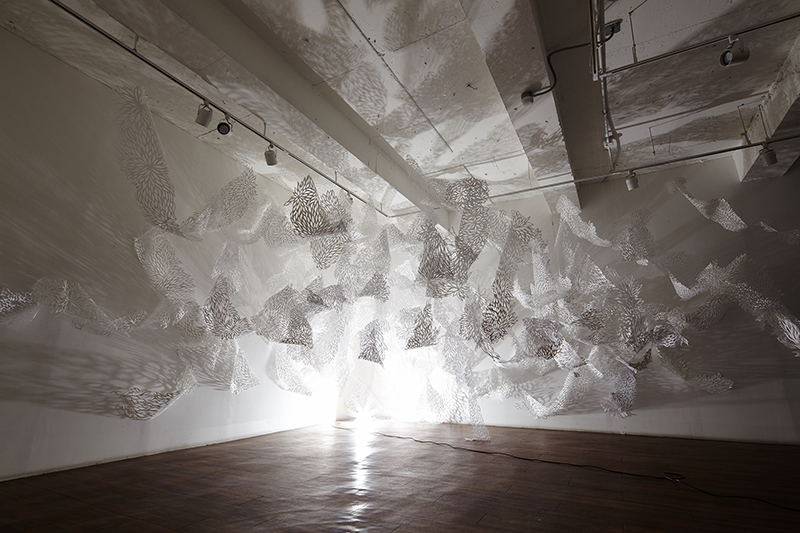
Summer Shower. Contemporary artist Jamie M. Lee. Hand cut paper. 2016 @And N Gallery, Seoul, Korea.
What is the primary role of an artist? How do you describe yourself in the context of challenging people’s perspectives via your work and art?
I think it depends on the artist’s inclination as well as the artwork. In my case, I find much meaning in communicating with others through my work. I may not play a great role in people’s lives as an artist, but if I can create a haven of beauty in their hearts if only for a moment through my work, I believe that’s an important role. A good book, good music and beautiful lyrics sometimes console those who are worn out. Similarly, I would like my work to become a bit of refuge for people. As a matter of fact, I once received an email from a total stranger that they had been comforted and happy if only for a moment through my work. This is the way I communicate with people via my artwork and also what I find meaningful as an artist. Therefore, I always tell myself that the most important outlook to keep as an artist is to work truthfully. Art that is not fake and is honest to my core is the only way I can truly communicate with the audience.

Living Dream, Contemporary artist Jamie M. Lee. Vinyl Sheet on Glass, 2,950X15,645mm, 2017 @PLACE 1, Seoul, Korea
How do you deal with the conceptual difficulty and uncertainty of creating work?
Because my work is based on spontaneous inspiration and not images that have been decided on beforehand, I always confront mishaps or processes of uncertainty. In addition, I always go through trial and error because I work with so many different materials. At times I must stop midway due to materials or colours that don’t cohere well since my images are produced and completed by layering different substances. At times like these, I must set that piece aside for a while and continue with another piece. This is because if I continue with only one project I too am unable to read into that piece. Therefore, I usually progress with three or four pieces at a single given time. This is the only way I am only able to control how the piece flows because I use such differing colours and images.
In my paintings and installations as well as media or graphic collaborations that I am trying anew, I always start out with uncertain information rather than assuredness since these are new fields I am venturing into. I learn through the process of a project, which I take into account for something better the next time. Creating a work of art means to create something certain out of something uncertain and that is a process the artist should take for granted. Also, working through that endless process should be an artist’s daily life. Ultimately, the most important thing that I am given to work with is how to unravel that ‘conceptual difficulty and uncertainty of creating work’.
What would you call your style?
I describe my style as ‘mixed media paintings’ or ‘mixed media installations’. Mixed media means exactly that; using various materials. For my paintings, the main material is acrylic paint, but I also use all sorts of other things such as tissue paper, ink, glitter, and gel medium. For my hand-cut paper installations, I use paper, but also other unlimited kinds of materials. Instead of using solely a limited material, I layer image on top of image through the natural process of using many types of materials to create one whole image. I improvise on the canvas without sketching or planning in advance for my paintings, hand-cut paper installations, and ink drawings.
Same goes for my hand cut paper installations, but unlike paintings, the audience can directly experience the effects of a three-dimensional space. Such paper installations have been transformed into public art when installed on glass walls inside buildings. Like so, the use of many different materials is an important element that broadens the scope of my work by opening numerous possibilities.
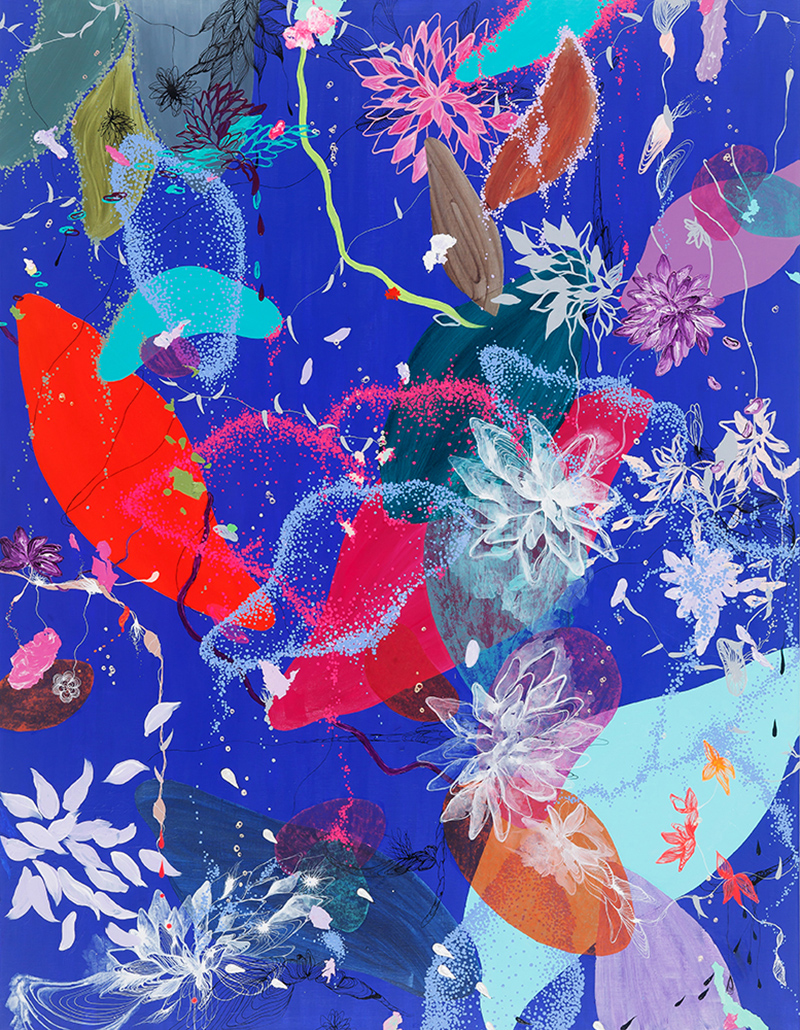
Summer Shower. Contemporary artist Jamie M. Lee. Acrylic, tissue paper, ink, on canvas. 57X44inch. 2017.
Let’s talk about the evolution of your practice over the years. Tell us about your commitment to your current medium.
In terms of practice, the images of my work have evolved over the years, but the fact that I use mixed media is something that has remained the same since my college years. Of course, materials have been added anew or omitted and while this process is repeated over and over better materials have found their way into my work. I majored in printmaking as well as painting in college. Instead of simply painting on the canvas, I would carve wood by hand and apply ink to roller to repeatedly layer images onto my paintings. My paintings also are not simply flat paintings that are conducted on a single layer. I first paint the background with acrylic paint and add a layer with tissue paper and add paint to that layer, ink drawing on top of that, gel medium, glitter and so forth. Therefore, my work is a compilation of independent images made of completely different materials. After starting out with painting, I now also create installations using mixed materials and paper.
Let’s talk about your career, or if you prefer artistic journey. What were your biggest lessons and hurdles along the way?
As my career started to gain momentum, as a matter of course I have been provided the chance to work with those in many different fields as well as galleries. I have encountered endless hurdles along the way when dealing with exhibition contracts with galleries, sales processes with dealers, and collaborating personally or with corporations. My artwork has been damaged during the exhibition process and payment for a piece would not go as promised despite having been sold already. In the case of collaboration, often I was not sure what exactly it was that I was supposed to bring to the table since much of the work would be connected with design, which is a field I am not familiar with. In such a case, one needs to study the unfamiliar parts in depth. Precise understanding is necessary of what you want to offer and what they have to offer. If trust is the only tool with which to work with, problems may arise later on that will make both parties uncomfortable. Many times things would ultimately flow in an unexpected direction when I was younger and hadn’t demanded a contract, working solely under the confidence of ‘trust’. What I have learned during the journey of my professional career is to make each step clear. Even if you’re working with a gallery or dealer who is a personal acquaintance, if that person is a professional, they will offer clarity to the process first. You need to be able to say precisely what you want if they don’t make things transparent or they offer something disadvantageous to the artist. I think this is something that an artist must show responsibility for.
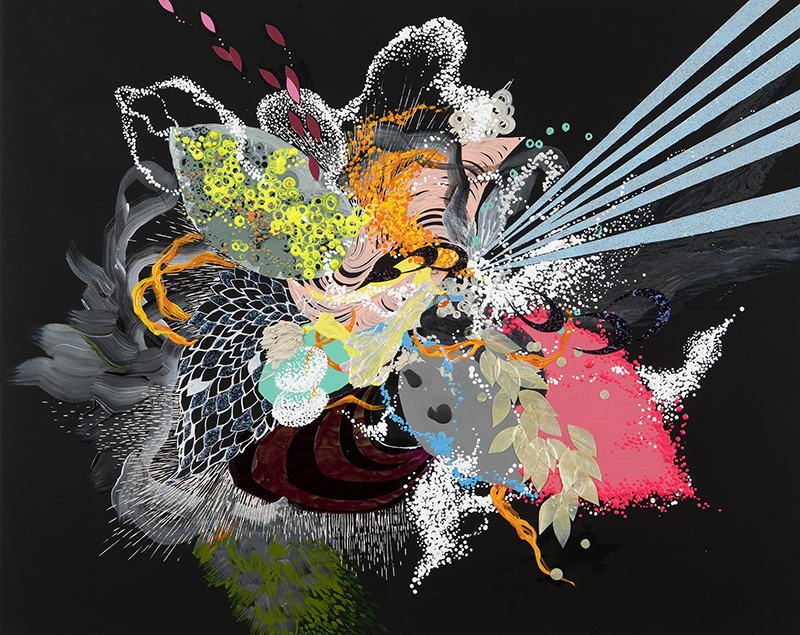
Make a Wish! Contemporary artist Jamie M. Lee. Acrylic, colored paper, ink, gel medium on panel. 16X20in. 2010.
How does your audience interact and react to the work?
Usually, the audiences’ first reaction to my work is, “It’s so beautiful!” What is amazing is whether it be the US, Korea, or China, which are the countries where I have exhibited my work, people have usually reacted the same way regardless of nationality or ethnicity. Of course, this reaction mostly pertains to women instead of men. Frankly, some artists may find the reaction to their artwork as “beautiful” to be offensive. Some artists think a beautiful piece of art only contains beauty and lacks substance. However, for me it may be that I am trying to communicate through beauty with the audience. Therefore, I think it’s great that the audience reacts this way, and this is the reaction that I want to evoke in others.
I always tell a story through my work to the audience. Another Miracle is an experience piece that says, “Anyone can make their dream come true if they truly want it.” Make a Wish expresses emotions of fear and hope for the future, which swept over me in the moment of blowing out the candles on my thirtieth birthday cake. These are abstract works that tell of things that are not only my story but things anyone may experience. When the audience learns of the story, they say, “It’s more beautiful!” Their reaction that my work is “beautiful” might concern the colours or images of the work, but I believe it also means they can relate to the story within the piece. I hope the audience recalls forgotten dreams and memories when they see my work.
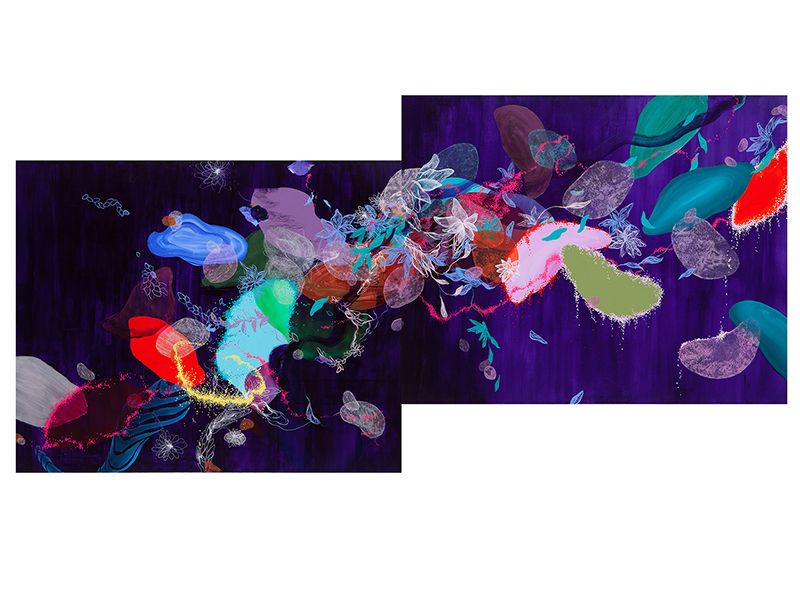
Another Miracle. Contemporary artist Jamie M. Lee. Acrylic, tissue paper, ink on canvas. 62X127.6inch. 2017.
What are you looking for when you look at other artists’ work? Which shows, performances and experiences have shaped your own creative process?
I often am inspired by work from different fields instead of shows or pieces of visual art, particularly more so when it comes to ideas for materials or colours. From this aspect, my experience living in New York is something that inspires me greatly even to this day. Visual art is not the only cultural experience one can gain in New York but also fashion, interior design, architecture and so on. I have been able to apply inspirations begotten from such multifarious cultural experiences into my artwork.
Perhaps this is why one particular show remains deeply embedded in my mind. It was the Alexander McQueen fashion exhibition that I saw at The Metropolitan Museum of Art in 2011. It was a different field from mine and I wasn’t particularly interested in fashion, which may be why it provided such a refreshing view point. Almost all of his work during his lifetime was on display. He was a designer whose life ended at the age of 40, and I was amazed at the many different materials and pieces he had designed during his short life. The variety of his work was so many and the stories in them so interesting. From classic, contemporary, to futuristic designs that were like witnessing outer space, I was able to see how much passion he put into his work by the many different materials and stories he had designed. In addition, the entire exhibition hall had been made into a fantastic space that enhanced his work; the stage, wallpaper, lighting, sound. Looking at his work made me resolve to create works with many different materials and stories instead of limiting myself to a single field. It also opened my eyes to how important the process of harmonising and planning out the exhibition space is not just the artwork itself.

Contemporary artist Jamie M. Lee @Ragdale Artist Residency, Illinois, USA
What was your first sale? Do you handle the commercials yourself or is it outsourced to a gallery or an agent?
My first sale was a woodcut print made in my junior year of undergraduate school. Of course, it was very cheap since I was a student and it was a print, but I remember how excited it made me to know that someone wanted my work to be a part of their collection. Once I became a full-time artist, I have been able to steadily personally sell my work to collectors. However, since working with commercial galleries, I have sold both through galleries and dealers. I have found that galleries and dealers are much more professional than me lf when it comes to sales and dealing with collectors and introducing my work to them. As an artist, I think it’s important to focus more on the creation of my work.
Tell us about your studio, what kind of place is it? Could you describe your usual work day in the studio?
In January 2020 I moved into a new residency in Korea named Youngeun Museum of Contemporary Art located in Gyeonggi-do Gwang-ju, which is a city about 30 minutes from the capital city, Seoul. The museum, which consists of a residency as well, is celebrating its twentieth anniversary this year. With a focus on Korean artists, foreign artists are also selected based on their application biennially for either short or long-term residencies. These artists are provided with a working studio for three months to as long as two years and are given the opportunity of a solo show at the museum during their residency. Above all, artists are facilitated with separate living and working spaces, which is convenient for foreign artists to do their work.
I stayed here for a 4 month short-term residency as a foreign artist in 2014 while still based in New York. It is a meaningful place for me, being my first residency in Korea as well as first studio. I have returned this year after six years for a one year residency. I would like to make a lot of good art while here in 2020 because personally I was able to create some decent work while here in 2014 and was able to take myself to another level as an artist.
I am usually in my studio unless I have an appointment or am out to an exhibition. For me, I work more efficiently when working in the evening than in the daytime. I think this has stemmed from my days as a graduate student when I would work late at night at the school studio. Perhaps this is why my concentration or creativity seems to flow better during the night than the day.
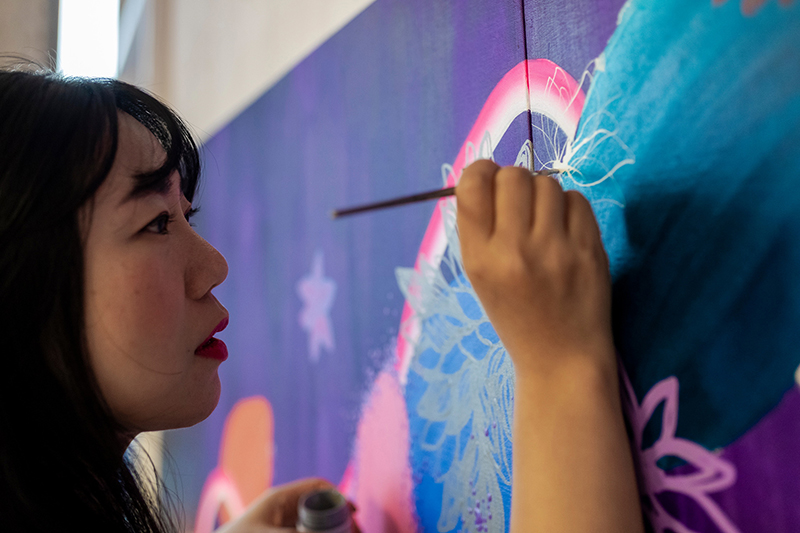
Contemporary artist Jamie M. Lee @Swatch Art Peace Hotel Artist Residency, Shanghai, China.
Artists often experience contradicting motivations when it comes to the commercial versus the creative. How do you strike a balance?
Naturally, I keep creativity in mind more when I work. Sometimes people comment on whose work is popular these days or which colour or style sells well, but I don’t let it concern me much because that is about another artist and collectors who prefer that type of work. This doesn’t mean I don’t care about selling. I’m an artist and selling one’s work is important for an artist. What I mean is that selling should not be the primary concern when creating one’s work.
I have sold my work steadily since I was in college. If I think about it, a work of art that the artist is satisfied with will almost always satisfy the collector. The value of a piece of art will only be acknowledged when I instill my own language into the work.
Let’s talk about your frameworks, references and process. What inspires you?
I create abstract paintings out of experiences that I have had in my life. They are not simply my own stories but also things that people may experience in their daily life. I express emotions such as faint memories rekindled at the sound of certain music, the sound of summer shower, the earnest wishing for a miracle, or wanting for a dream to come true in my own visual language.
Because my inspiration primarily derives from my environment, I want to experience many things from new places rather than being rooted to a single place, which is how I came to the conclusion on residencies. Residencies provide a working space along with the opportunity to show my work to many people from many different places. Moreover, it’s a way to reduce costs as much as possible. However, the biggest reason is because I would like to experience the stories of people coming from other environments. The stories of my artwork are created by the stories from people of different colour and language and way of life and what I feel from their stories. The feeling of unfamiliarity from being in a new environment always gives new inspiration to my work.

When october goes. Contemporary artist Jamie M. Lee. Acrylic, tissue paper, ink on panel. 18X24inch. 2016.
How do you feel about commissions?
There are two types to this. One is when an individual collector orders a painting on commission and the other is by a corporation or personal collaboration. At times there will be a collector who asks for a painting in a particular size or a similar painting to one that has already been sold, but in my experience because the piece is created under a set purpose I can’t seem to put as much of my emotions into it as much as my other works. It’s just like working in a rush to meet a due date. I feel ill at ease. Therefore, I prefer to recommend already existing works to collectors.
However, it’s a different case for corporations or personal collaboration projects. I cannot proceed with my own style or inspirations because the project is conducted to suit a particular purpose. Of course, I do put in my inclinations, but I must reflect design elements or if there is an element which I am not an expert in, I must take the expert’s opinion under consideration. This is also true for collaborations. In such a case, I accept the commission and create accordingly.
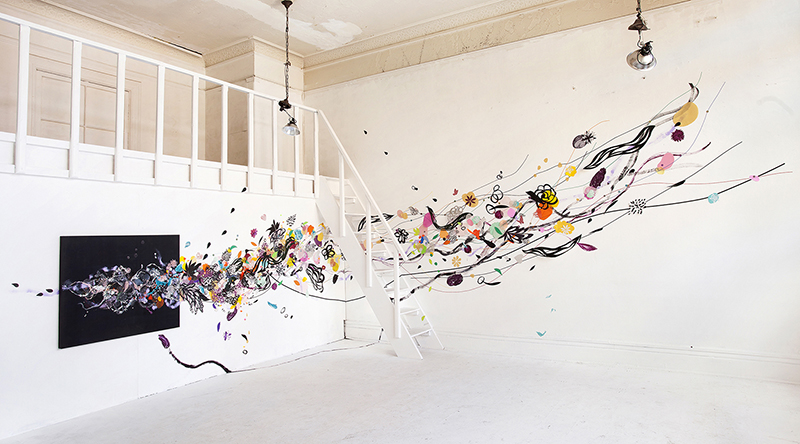
Living Dream. Contemporary artist Jamie M. Lee. Hand cut paper and mixed media installation. 2012. @PS 122 Project Studio, New York, USA.
What are you working on now? What’s coming next season?
I am planning to have a solo exhibition at White Block Art Centre in the spring of 2021. It’s been four years since I have opened a solo show in 2017, therefore greatly meaningful for me. White Block Art Centre is also the organisation for a residency where I worked in 2015-2017. This art centre consists of five exhibition halls and I am planning to place pieces of various media on display. While it will be focussed on paintings, I would like for the audience to have a variegated experience by also exhibiting installation, media, and public art. This is yet another challenge for me, as the method is one I have never attempted before in a solo show. I would be honoured if The Asian Curator would interview me again during my spring solo show next year.
Before you go – you might like to browse our Artist Interviews. Interviews of artists and outliers on how to be an artist. Contemporary artists on the source of their creative inspiration.












Add Comment